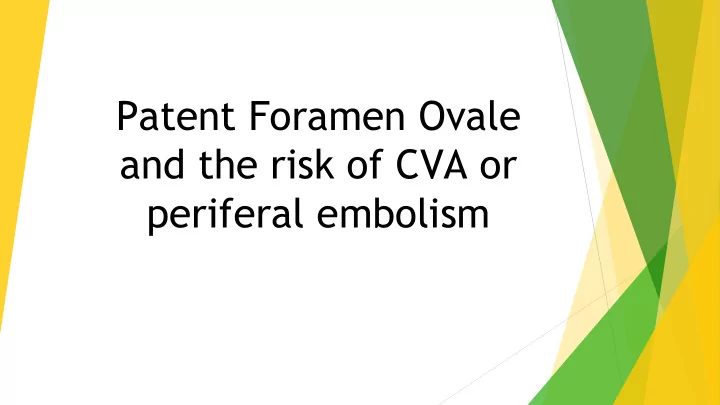

Patent Foramen Ovale and the risk of CVA or periferal embolism
Jan-Eize Lindeboom, cardioloog. St Elisabeth Hospital en Curacao Medical Center Commissie lid NVVC voor schrijven leidraad PFO closure Geen belangenverstrengelingen.
Editorial, NEJM 2013 Still No Closure on the Question of PFO Closure ● Steven R. Messé, M.D., ● and David M. Kent, M.D. In approximately 30% of young survivors of stroke, no clear cause is identified despite a thorough evaluation. Patent foramen ovale is found on transesophageal echocardiography in about half of these patients, as compared with approximately 25% of the general population. Clinicians, then, often assume that the patent foramen ovale was the cause of the stroke, although it may be incidental in some patients. The most effective strategy for the prevention of stroke recurrence in such patients is uncertain, and some experts recommend closure of the patent foramen ovale to prevent future embolic events, although high-level data have been lacking.
Original Article, NJEM sept 2017 Patent Foramen Ovale Closure or Antiplatelet Therapy for Cryptogenic Stroke Lars Søndergaard, M.D.,Scott E. Kasner, M.D.,et al. Gore REDUCE Clinical Study Investigators In this trial involving patients with cryptogenic ischemic stroke, the risk of recurrent stroke, including clinical ischemic stroke and a composite of clinical and silent brain infarctions, was significantly lower with PFO closure plus antiplatelet therapy than with antiplatelet therapy alone. The number of patients who needed to be treated to prevent one stroke in 24 months was approximately 28 patients.
Long-Term Outcomes of Patent Foramen Ovale Closure or Medical Therapy after Stroke Jeffrey L. Saver,John D. Carroll,et al. RESPECT Investigators *
The evidence for causation of embolic stroke in any given person is, of course, circumstantial (e.g., atrial fibrillation or carotid stenosis), and it seems reasonable that the presence of a PFO and a sizable interatrial shunt should similarly no longer result in the categorization of a stroke as cryptogenic. One conclusion from the trials is that the potential benefit from closure is determined on the basis of the positive characteristics of the PFO rather than on the basis of exclusionary factors that make a stroke cryptogenic. Restricting PFO closure entirely to patients with high- risk characteristics of the PFO may perhaps be too conservative.
Original Article, NEJM 2019 Dabigatran for Prevention of Stroke after Embolic Stroke of Undetermined Source RE-SPECT ESUS Steering Committee and Investigators * In patients with a recent history of embolic stroke of undetermined source, dabigatran was not superior to aspirin in preventing recurrent stroke.There were more clinically relevant nonmajor bleeding events in the dabigatran group.
Take home message After a cortical infarction, a large shunt and/or Atrial Septum Aneurysm identified with contrast echocardiography, in a non smoking, less than 60 years old patient with no clear atherosclerotic disease, atrial fibrillation or hypertension may be a candidate for PFO closure. Jan-Eize Lindeboom, cardioloog. St Elisabeth Hospital en Curacao Medical Center
Recommend
More recommend